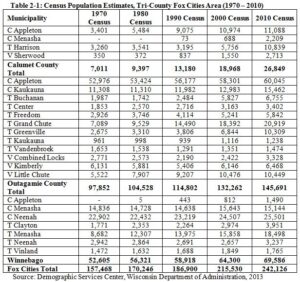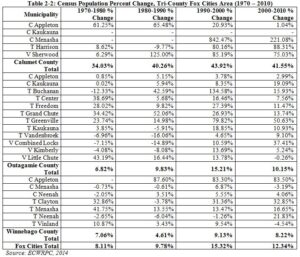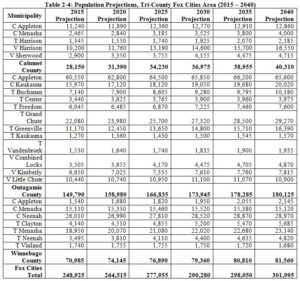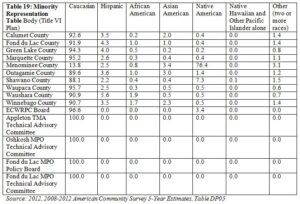Serving Calumet, Fond du Lac, Menominee, Outagamie, Shawano, Waupaca, and Winnebago counties.
MPO Area & Organizational Structure
1) Describe the roles and authorities of the Commission & committees in terms of MPO responsibilities.
Policy Board Structure
East Central WI Regional Planning Commission (ECWRPC) is comprised of membership from eight counties within the region (Calumet, Fond du Lac, Menominee, Outagamie, Shawano, Waupaca, Waushara, and Winnebago counties). Each county’s commissioners are members of ECWRPC’s Policy Board, which meets on a quarterly basis. The structure of the organization has changed over time in that as a result of TMA designation, two ex-officio members have been added to the Policy Board; one is the manager of Valley Transit and the other is a Representative from WisDOT Northeast Region. In addition, Fond du Lac County recently rejoined the Commission in 2015, after an absence since the early 1980s. Below is a brief description of the how representation is determined:
ECWRPC Structure & Policy Making Process
Commission Structure
The basic representation on the Commission’s policy body consists of three commissioners from each county as follows to vote on MPO responsibilities:
- The chairman of the county board serves on the Commission because of his/her elective office.
- A second member is appointed by the county board. This individual must hold executive or legislative elective office within town, village, city or county governmental bodies with the appointing county. This member is automatically the county executive, if the county has one.
- A third member is appointed by the Governor from a list of six persons nominated by the county board. At least four of these nominees must by private citizens.
- Additional representatives are provided to counties with a population of 50,000 or greater, one for each attained increment of 50,000. The first additional representative is the mayor or council president of the largest city in the county, while subsequent additional members are appointed in a manner similar to the second member appointment procedures noted above.
Source: Appleton LRTP, Chapter 1, Page 1-3
2) What is the voting structure of the MPO Policy Board (Commission) and advisory committees? (e.g. One vote per member? Vote by population weight? Combination?)
Transportation Policy Advisory Committee (TPAC)
The Transportation Policy Committee (TPAC) facilitates regional participation and consensus building on transportation-related issues through a continuing, comprehensive, and coordinated planning process. The TPAC is composed of elected officials and board members of local governments and transportation agencies within the East Central Wisconsin Region; plus representatives from Federal Highway Administration and Wisconsin Department of Transportation. The TPAC serves as an advisory body to the Transportation Committee and the Commission on transportation related issues.
Technical Advisory Committee (TAC)
The Technical Advisory Committee (TAC) facilitates regional participation and consensus building on transportation-related issues through a continuing, comprehensive, and coordinated planning process. The TAC is composed of planners, engineers, and operators of local governments and transportation agencies within the East Central Wisconsin Region; plus representatives from Federal Highway Administration and Wisconsin Department of Transportation. The TAC serves as an advisory body to the TPAC.
Transportation Committee
The Transportation Committee is comprised of 9 Commission members. This committee directs and monitors the transportation program element and maintains liaison with the Transportation Policy Advisory Committees and the Transportation Technical Advisory Committee. This committee is responsible for overseeing the transportation element of the regional plan.
Full Commission
See question 1 for Full Commission description. Approval process: Items for approval start with the TAC and TPAC, then forwards to the Transportation Committee and then to the Full Commission for final approval.
Source: Annual Report 2015-2016, page 5
3) Explain any differences in the roles and authority of the adhoc transit and WisDOT representatives on the Commission compared to those of the Commissioners? Where is any distinction documented?
There isn’t any distinction between ad-hoc members/ex-offico (Valley Transit and WisDOT) compared to Commissioners.
Source: ECWRPC Bylaws
4) Provide a breakdown of UZA and MPA population & demographics by County & municipality.
 Source: Appleton LRTP, Chapter 2, Page 2-2
Source: Appleton LRTP, Chapter 2, Page 2-2
It should be noted that the TMA total population does not exactly match the Census estimate of 216,154.
 Source: Appleton LRTP, Chapter 2, Page 2-3
Source: Appleton LRTP, Chapter 2, Page 2-3
 Source: Appleton LRTP, Chapter 2, Page 2-5
Source: Appleton LRTP, Chapter 2, Page 2-5
5) Provide a breakdown of the demographics of the Commission and committee members.
Stakeholders:
- Total population – 651,835 (2010 US Census)
- Total minority population – 49,310 (2010 US Census)
- Total Hispanic or Latino – 23,054 (2010 US Census)
- Total Low Income – 63,118 (2012 ACS 2008-2012)
(Title VI Plan)
 Source: ECWRPC Title VI Non-Discrimination Plan & Limited English Proficiency Program, Page 31
Source: ECWRPC Title VI Non-Discrimination Plan & Limited English Proficiency Program, Page 31
Please be prepared to discuss the following at the site review meeting. A written response is not required.
- Provide a brief overview of the TMA area highlighting any special transportation projects or issues.
- Health in transportation framework with college avenue corridor
- How has becoming a TMA changed what the MPO does?
- Added the congestion management plan
- Hasn’t really changed a lot
- Changed make up of policy board – based on guidance from FHWA
- Involved in 53.10 – Coordination
- Administering the Transportation Alternatives Program
- How are the various local implementing agencies within the MPO planning area represented on the policy board (Commission)?
- Through elected officials from their member counties including the City of Appleton and the TAC.
- How is the interest of the MPO planning area assured in MPO-related decisions given the Commission membership and voting structure?
- UZA representation far out numbers the rural populations –
- TAC, TPAC, and bicycle and pedestrian advisory committee are comprised of urbanized area representation
- What is being done to engage and include the MPO municipalities and operators of major modes of transportation that aren’t represented on the policy board?
- Technical advisory committee and bicycle and pedestrian advisory committee and transit commission; continuous outreach and meetings with local municipal and county staff.
- Where are the roles and authorities of the various committees documented, including structure, membership, voting, and etc.?
- East Central bylaws, annual report and LRTP

